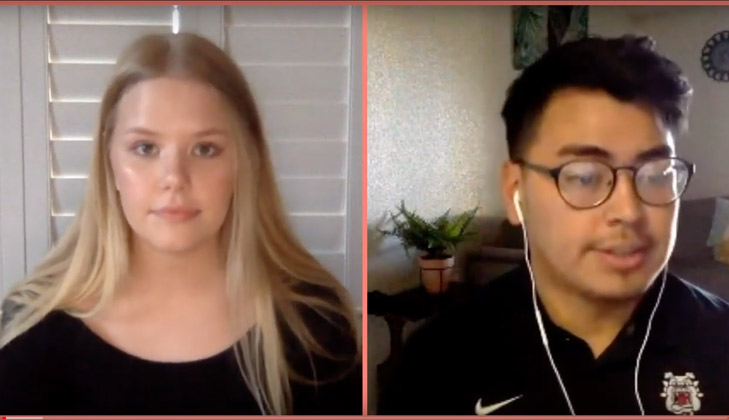In a crisis situation, journalists need to be nimble and provide the public with accurate information while remaining safe themselves. It is a lesson that is difficult to teach without actually being in the situation, which is why many Fresno State journalism students attend the annual “Camp News” for specialized mock training. However, this week, students experienced a real crisis and found real solutions to bring their reporting to the public.
With the spread of COVID-19, University guidelines called for in-person classes to move to virtual instuction — making a traditional newscast impossible. The student journalists who produce the weekly Fresno State Focus newscast faced a huge challenge. If they wanted to continue to provide the campus and community with news during the crisis, they needed to create an entire newscast without a studio or control room.
“I think it was a great learning experience. We tried something new and made it work,” said Mayra Franco, Fresno State student. “As student journalists, we’re seeing that even during a crisis, our work matters, and we can still work from home.”
Rather than broadcasting from the studio, anchors Joanne Voos and Gio Alvarado opened the newscast side by side, but each in their own homes, using an app on their cell phones.
“We used an app called ‘Be.Live.’ It was the first time we used it and there was a bit of a learning curve. The app allowed us to roll videos and insert graphics,” said Associate Professor Faith M. Sidlow.
She went on to explain that, due to time constraints, the show was produced and recorded live from the mobile app, but lightly edited afterward to produce the final newscast.
Students said the biggest challenge they faced was maintaining social distance while developing their stories.
“Interviewing the interviewee was challenging. As a journalist, we must be a prime example of following social distancing and having good manners,” said Gio Alvarado, Fresno State student.
Not only was the newscast created with everyone in separate locations using a mobile workflow, but planning the newscast was also completely mobile. Students used the Zoom online conferencing service to plan the newscast — then continued on Zoom to coordinate during the live portion of the newscast.
“We learned to work together as a team without being physically with each other,” said Melissa Munoz, Fresno State student. “In the end, we made it work and couldn’t have made it possible without everyone’s hard work and dedication — as well as the professors working their best to make it happen.”
Sidlow said the entire process was inspiring.
“I am so gratified and impressed by these students. I have learned more from them about optimism, gumption and grit than I have at any other time.”
VIDEO CLARIFICATION NOTE:
In an effort to limit the spread of COVID-19, and under the direction of the CSU Office of the Chancellor, most campus offices that are not essential to direct student support have transitioned to working remotely, while virtual instruction continues.
Use of the Henry Madden Library will be limited to essential services including the DISCOVERe Hub and other library resources (including the Center of Faculty Excellence) that are focused on supporting delivery of virtual instruction. For more information, visit: http://fresnostate.edu/president/coronavirus/.





